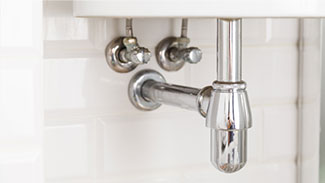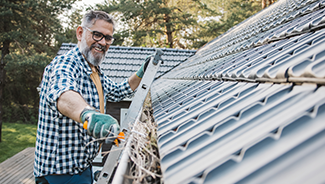
Regularly checking potential trouble areas around your pipes and connections can help prevent leaks from occurring.

Water leaks are the number one cause of damage in homes, resulting in billions of dollars of damage each year. In fact, about 1 in 60 homes in the U.S. are expected to experience a claim related to water damage this year.
The good news? Water leaks are usually preventable! Here are some common water leak problem areas you should keep an eye on, tips for spotting a hidden water leak, and what to do if you find a leak or water damage in your home.
Water supply lines are often the main source of a water leak in your home. When you install any new appliance that uses water, be sure to use new supply lines and connections, too.
Another hotspot for water damage is your refrigerator's water line leading to the ice maker. If you see water pooling around your refrigerator, it's possible that the connections need to be tightened, or the ice maker water line needs to be replaced.
A leaky dishwasher can also lead to damage in your kitchen. If your dishwasher has a kick plate, remove it and check there first for a leak. Then, check around your dishwasher's gaskets. Finally, test the seal by shutting a piece of paper in the door and trying to pull it out; if the paper slides out easily, you'll know it's time to replace the seal.
A broken washing machine hose can discharge up to five hundred gallons of water an hour—that's some major damage in a short amount of time!
To keep your water hoses in good condition, replace them every five years, or when you install a new washing machine. Also, if you have hard water, you may want to replace them more frequently, or at least monitor the connections for mineral buildup that can damage the hoses and cause blockages.
You should also inspect your hoses more regularly for loose connections, blisters, cracks, and worn tubing. Consider adding it to your to-do list when spring cleaning your washer and dryer or protecting your pipes against winter weather.
Finally, some general tips for keeping your washing machine in good shape and preventing unexpected water damage include never overloading it (which may cause water to overflow or slosh out), and only running the washer if someone is at home.
Sediment buildup in your water heater can clog water lines. Flush your water heater yearly using the manufacturer's instructions to drain and flush the tank.
Bathrooms are prime areas for water leaks. Check for leaks under the sink, and watch for puddles around the bases of showers, tubs, and toilets.
Older or worn-out toilet flappers are a common source of water leaks in toilets, and they should be replaced at least every five years. Replacement is typically quick and easy, and parts can be purchased from your local hardware store. However, always contact a certified plumber for assistance if you're not comfortable making repairs on your own.

Some leaks are more obvious than others. For example, you may notice a puddle of water at the base of your dishwasher right away, but other signs of a leak can be much harder to spot.
Unfortunately, this also means that hidden leaks can cause a lot of damage before you even realize they’re there. If you see any of these signs of a hidden leak, call a certified professional plumber right away.
Even small leaks can waste thousands of gallons of water, causing a large increase in your bill. If you notice that your water bill is suddenly higher than normal, that's key sign to start checking for leaks throughout your home.
With any kind of water leak, it's important to act fast to prevent major damage to your home, no matter how small the issue may seem.
First, take photos of the leak and document any signs of damage in case you need to file a home insurance claim.
Then, if you’re not comfortable making minor plumbing repairs yourself, it’s always best to reach out to a certified plumbing professional. And if you spot signs of a hidden leak, or see extensive water damage, then it’s definitely time to call in the experts for assistance.
The information we share on our site is intended to serve as a general overview. Please refer to your policy or contact your local independent agent for specific coverage details.
Source: 1. "Facts + Statistics: Homeowners and renters insurance," Insurance Information Institute, Inc., accessed February 2, 2024. | 2. Glenda Taylor and Bob Vila, "How to: Find a Plumbing Leak,” Bob Vila, updated December 22, 2020. | 3. "9 Signs You Have a Water Leak,” Simply Green Plumbing, accessed February 2, 2024.

Regularly checking potential trouble areas around your pipes and connections can help prevent leaks from occurring.


Service line coverage protects the underground utility lines on your property. Here's everything you need to know.